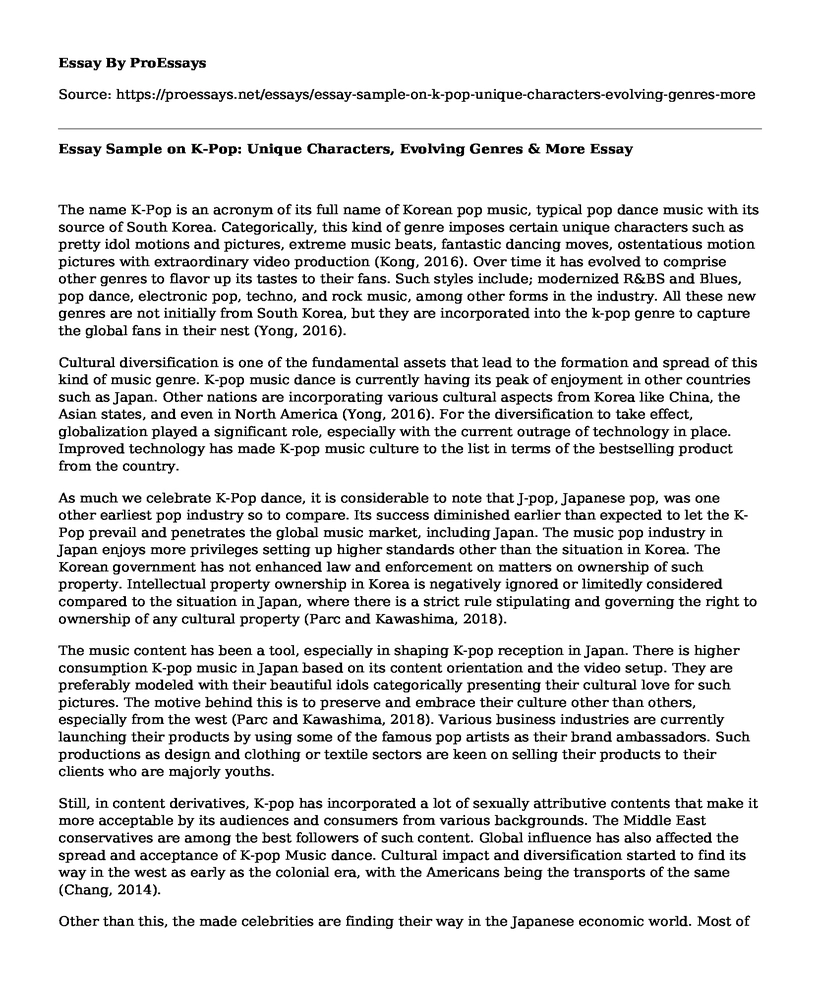The name K-Pop is an acronym of its full name of Korean pop music, typical pop dance music with its source of South Korea. Categorically, this kind of genre imposes certain unique characters such as pretty idol motions and pictures, extreme music beats, fantastic dancing moves, ostentatious motion pictures with extraordinary video production (Kong, 2016). Over time it has evolved to comprise other genres to flavor up its tastes to their fans. Such styles include; modernized R&BS and Blues, pop dance, electronic pop, techno, and rock music, among other forms in the industry. All these new genres are not initially from South Korea, but they are incorporated into the k-pop genre to capture the global fans in their nest (Yong, 2016).
Cultural diversification is one of the fundamental assets that lead to the formation and spread of this kind of music genre. K-pop music dance is currently having its peak of enjoyment in other countries such as Japan. Other nations are incorporating various cultural aspects from Korea like China, the Asian states, and even in North America (Yong, 2016). For the diversification to take effect, globalization played a significant role, especially with the current outrage of technology in place. Improved technology has made K-pop music culture to the list in terms of the bestselling product from the country.
As much we celebrate K-Pop dance, it is considerable to note that J-pop, Japanese pop, was one other earliest pop industry so to compare. Its success diminished earlier than expected to let the K-Pop prevail and penetrates the global music market, including Japan. The music pop industry in Japan enjoys more privileges setting up higher standards other than the situation in Korea. The Korean government has not enhanced law and enforcement on matters on ownership of such property. Intellectual property ownership in Korea is negatively ignored or limitedly considered compared to the situation in Japan, where there is a strict rule stipulating and governing the right to ownership of any cultural property (Parc and Kawashima, 2018).
The music content has been a tool, especially in shaping K-pop reception in Japan. There is higher consumption K-pop music in Japan based on its content orientation and the video setup. They are preferably modeled with their beautiful idols categorically presenting their cultural love for such pictures. The motive behind this is to preserve and embrace their culture other than others, especially from the west (Parc and Kawashima, 2018). Various business industries are currently launching their products by using some of the famous pop artists as their brand ambassadors. Such productions as design and clothing or textile sectors are keen on selling their products to their clients who are majorly youths.
Still, in content derivatives, K-pop has incorporated a lot of sexually attributive contents that make it more acceptable by its audiences and consumers from various backgrounds. The Middle East conservatives are among the best followers of such content. Global influence has also affected the spread and acceptance of K-pop Music dance. Cultural impact and diversification started to find its way in the west as early as the colonial era, with the Americans being the transports of the same (Chang, 2014).
Other than this, the made celebrities are finding their way in the Japanese economic world. Most of the television and radio are currently hosting such celebs irrespective of their nation of origin. One of the best examples is Boa, who is a Korean singer, participated in the 2005 APEC programs, JI- Woo shake hands with Koizumi (Japanese Prime Minister) in the very year creating a unifying tie between the two nations (Kozhakhmetova, 2012).
References
Chang, Y. (2014). Research on the Identity Construction of Korean Pop Music's Fandom Groups on the Weibo Platform: Exemplified by G-Dragon. (Kwon Ji-Yong)
Kong, Y. H. (2016). The Globalization of K-Pop: The Interplay of External and Internal Forces. Furtwangen University
Kozhakhmetova, D. (2012). Soft Power of Korean Popular Culture in Japan: K-pop Avid in Tokyo. Lund University.
Parc, J. & Kawashima, N. (2018). Wrestling with Or Embracing Digitization in The Music Industry. The Contrasting Business Strategies of J-pop and K-pop. Doshisha University.
http://journals.ateneo.edu/ojs/kk/
Cite this page
Essay Sample on K-Pop: Unique Characters, Evolving Genres & More. (2023, Mar 20). Retrieved from https://proessays.net/essays/essay-sample-on-k-pop-unique-characters-evolving-genres-more
If you are the original author of this essay and no longer wish to have it published on the ProEssays website, please click below to request its removal:
- Relevance of Ghosts of Abu Ghraib with Respect to the Military Police and Interrogators Who Participated
- Mukbang-Live Show: Vicarious Satisfaction of Free Money Essay
- The Big Bang Theory - Television Show Analysis Essay
- Essay on Selena Quintanilla: Queen of Tejano Music & Tragic End at 23
- Essay Sample on Digital Diplomacy: How Twitter is Changing the Global Landscape
- Mark Zuckerberg: From Face Match to Facebook CEO - Research Paper
- Social Media Use - Essay Example







